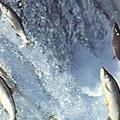 美國哥倫比亞河部落與聯邦機構7日 提出一項規模龐大的鮭魚保育協議,並開放公眾評論。這項十年計畫將投入九億美元,目標在改善棲地環境,復育哥倫比亞河流域濱危的鮭魚族群。但評論認為,位於蛇河下游(Lower Snake River)的四座水壩阻擋鮭魚洄游路徑,在計畫中卻未考慮拆除,因此保育效果可能有限。
美國哥倫比亞河部落與聯邦機構7日 提出一項規模龐大的鮭魚保育協議,並開放公眾評論。這項十年計畫將投入九億美元,目標在改善棲地環境,復育哥倫比亞河流域濱危的鮭魚族群。但評論認為,位於蛇河下游(Lower Snake River)的四座水壩阻擋鮭魚洄游路徑,在計畫中卻未考慮拆除,因此保育效果可能有限。
布希政府先前的鮭魚保育計畫由於與濱危動物法案衝突而進入訴訟程序,因此希望透過這項保育協議讓長達十年的官司得以落幕。經過兩年的廣泛協商,4個部落與3個聯邦機構終於達成共識,並交付公眾評論。
根據協議內容,聯邦機構將在10年內撥款九億美元,除了繼續現有的保育行動,也將與部落共同執行新的鮭魚計畫。絕大部份的經費將由聯邦能源仲介機構BPA(Bonneville Power Administration)提供,BPA負責銷售哥倫比亞河流域31個聯邦水力發電設施所產生的電力。
本協議在鮭魚保育及水力發電系統之間找出共同目標,並協調優先順序,包括新增發電廠、棲地復育及養殖行動、提供更明確的生態改善目標,並確保十年的經費供應。
非營利律師事務所Earthjustice等評論認為,這項協議對鮭魚的助益不大,因為阻擋鮭魚在河川及海洋間洄游的四座水壩並未被移除。
支持拆除水壩的人士指出,四座水壩製造出靜止的湖水,妨礙河水自然流動,讓新生鮭魚無法游向海洋。水壩也阻擋成年鮭魚洄游到高山的低水溫流域產卵,依賴冷水生存的鮭魚已經因為氣候變化面臨危機,情況可能更加雪上加霜。
 然而奧勒岡暖泉保留地聯合部落的首領蘇帕(Ron Suppah)對此協議樂見其成。他表示,「針對鮭魚所遭遇的種種問題,我們打造了積極的解決計畫。我們的目標與努力方向都是當前迫切需要的項目,包括復育魚群、提供部落漁業資源,並找出實際的解決方式而不只是空口指責。」
然而奧勒岡暖泉保留地聯合部落的首領蘇帕(Ron Suppah)對此協議樂見其成。他表示,「針對鮭魚所遭遇的種種問題,我們打造了積極的解決計畫。我們的目標與努力方向都是當前迫切需要的項目,包括復育魚群、提供部落漁業資源,並找出實際的解決方式而不只是空口指責。」
在保育鮭魚與拆除水壩的兩難取捨間,還有另一個需要考慮的因素。有些巨大的水壩實在難以移除,例如位於哥倫比亞河上游、美國最大的深谷大壩(Grand Coulee Dam)。
在哥倫比亞河與蛇河流域最上游的水潭裡,產卵的紅鮭(Sockeye Salmon)族群原本高達三百萬尾,但在1941年深谷大壩與其他數個主要水壩完工後,鮭魚洄游通道受到攔阻而數目驟降,如今僅有少數一兩個湖泊內有紅鮭存活。
需要了解更多訊息,可上鮭魚保育協議公眾評論網站:http://www.bpa.gov/comment
Columbia River Basin tribes and federal agencies today announced the start of a public comment period for an unprecedented $900 million, 10 year set of proposed agreements and actions to improve habitat and strengthen endangered salmon stocks in the Columbia River Basin.
Critics say the deal does not go far enough because it does nothing to remove four federal dams on the Lower Snake River that block the salmon's passage to and from the sea.
The agreement is intended to end decades of litigation and would specifically resolve Endangered Species Act litigation over the Bush administration's salmon plan.
Now, as the result of two years of extensive negotiations, four tribal groups and three federal agencies have produced the agreements that are presented for public comment.
Under the agreements, the federal agencies would make available $900 million over 10 years to continue existing programs and to implement new priority fish projects with the tribes.
Most of funds would be provided by Bonneville Power Administration, BPA, a federal power broker that markets wholesale electrical power from 31 federal hydro projects in the Columbia River Basin.
The agreements provide common goals and priorities for hydro system mitigation; additional hydro, habitat and hatchery actions; greater clarity about biological benefits and secure funding for 10 years.
Critics such as the nonprofit law firm Earthjustice says, the agreements are of little benefit to the salmon because the four dams that block their access from stream to ocean and back again are still there.
Dam removal proponents point out that the four dams create still water and impair the natural river flows young salmon need to migrate to sea. The dams hinder the migration of adult salmon trying to return to spawn in cold, high elevation tributaries, raising the risk that climate change will prevent these salmon from ever reaching the cold water they need to survive.
But Chairman Ron Suppah, Confederated Tribes of the Warm Springs Reservation of Oregon, is pleased with the agreement. "We have built an aggressive plan that fixes problems wherever the fish encounter them," Suppah said. "Our plan gets the focus and energy where it must be now - on recovering fish, providing opportunity for our tribal fishers and on finding real solutions rather than blame."
In the struggle between salmon and dams, some dams are just too large to remove, such as the giant Grand Coulee Dam on the upper Columbia River, largest in the United States.
Runs of sockeye salmon once as large as three million fish spawned in nursery lakes in the uppermost reaches of the Columbia and Snake River basins. But upstream passage was blocked by the construction of several key dams including the Grand Coulee Dam, completed in 1941, and now the sockeye are down to a remnant population in one or two lakes.
For more information on the public process, please visit www.bpa.gov/comment
全文及圖片詳見:ENS







